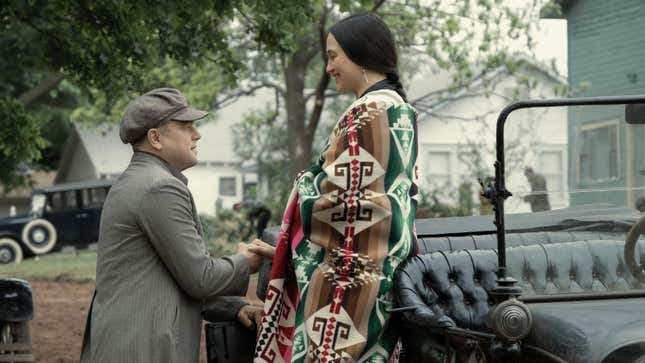
In a pivotal scene late in Killers Of The Flower Moon, a wife asks her husband a straightforward yes or no question. His hesitancy and inability to give her the answer she so clearly desires and deserves is at the heart of this complex character study from master filmmaker Martin Scorsese. Killers Of The Flower Moon derives its story from a very dark chapter in early 20th-century American history, the murder of the Osage indigenous people by white men for their oil wealth. What makes it fascinating is the specific angle the film takes to tackle this vast story; the film is a portrait of an ineffectual man who still manages to inflict a lot of harm. Someone who, against his better judgment and despite knowing all the facts, chooses to do the wrong thing time and again. It’s an epic tale told through the lens of an intimate, elusive, and ultimately tragic love story.
Adapted by Eric Roth and Scorsese and based on David Grann’s best-selling book, Killers Of The Flower Moon is about Ernest Burkhart (Leonardo DiCaprio), a recently discharged World War I veteran and his courtship of Mollie Kyle (Lily Gladstone), an Osage woman who comes from money and is looking to start a family. Ernest has no discernible skills or appetite for work; he just needs a wife with money. That’s when his uncle, William “King’’ Hale (Robert De Niro), sends him in Mollie’s direction. Surprisingly, they fall for each other. Not immediately, though. They take their time sizing each other up since they both know their motives might not be entirely honest. Tentatively they find warmth and companionship in each other. However, before long, they get enmeshed in Hale’s diabolical schemes.
As Burkhart, DiCaprio transforms, but not in the way an actor in a prestige film is expected to, with makeup prosthetics and weight fluctuations. Rather smartly, DiCaprio chooses a character he hasn’t played before; a befuddled and dumb man who keeps getting himself in trouble. He’s a man who makes stupid choices but can’t help himself. All of this is played on his face; his reaction to what’s happening around him is what pops. He registers Burkhart’s every bit of confusion, bemusement, and bewilderment. It’s a performance of a thousand faces registering one man’s grand failure.
Unlike DiCaprio, whose body seems to never stop moving, Gladstone gives a quiet performance of slow, determined moves. Her Mollie might not say much, but she’s never passive. She moves the way that someone with a lifelong history of facing and overcoming casual racism would. The introduction of the character in voiceover belies the source of its strength. As Mollie tries to find out what’s happening to her and her people, and why everyone around her is being murdered, Gladstone modulates her voice to convey the injustice that’s happening. She plays Mollie as someone resigned to her fate but determined to survive against the odds.
Despite the film concentrating on the love story between Ernest and Mollie, the performance that leaves the most indelible mark is De Niro’s. With his eyes framed by round specs and his voice threatening yet charming, De Niro slithers away with the film. He brings many of the mannerisms audiences have come to know and like about him. Let’s call them the De Niro specialities; that trademark smirk, and his way of talking fast and intimidating others. Yet he spins it all into a towering performance of a fascinating historical villain. De Niro veers dangerously close to caricature—making chirpy noises, always tilting his head, adding dashes of comedy—yet he ends up personifying evil while never sanding off the edges of this horrible man or trying to explain away his misdeeds with a humanist approach. In a smaller role as Mollie’s sister Anna, Cara Jade Myers is a dangerously unsettling presence that hints at how constant violence can shake up people in unexplainable ways.
Scorsese’s collaboration with Thelma Schoonmaker, who has edited every non-documentary film he’s directed since 1980's Raging Bull, feels different this time around. The pace is more languid, allowing the performances to settle in and take shape at their own rhythm. However, there are also nods to their legendary depictions of violence in how Killers Of The Flower Moon shows the casual premeditated eradication of the Osage. Mundane details of how murder is committed take center stage in a few breathtaking sequences; who plans these murders, who executes them, and who ferries messages around to ensure all is completed. It’s like a how-to manual of murder. The violence is bloody, but it’s the planning and premeditation that shows how awful it is.
Scorsese has always chronicled how America obtains its power and position over the rest of the world and the rotting underbelly of that status. The milieu might be different but that truth remains at the heart of his storytelling. Sometimes accused of glorifying violence, here Scorsese presents it in its ugliest shape; deliberate and intentional. Killers Of The Flower Moon is as momentous as the country it’s set in and as full of history as the people whose murder it depicts.
Killers Of The Flower Moon opens in theaters on October 20